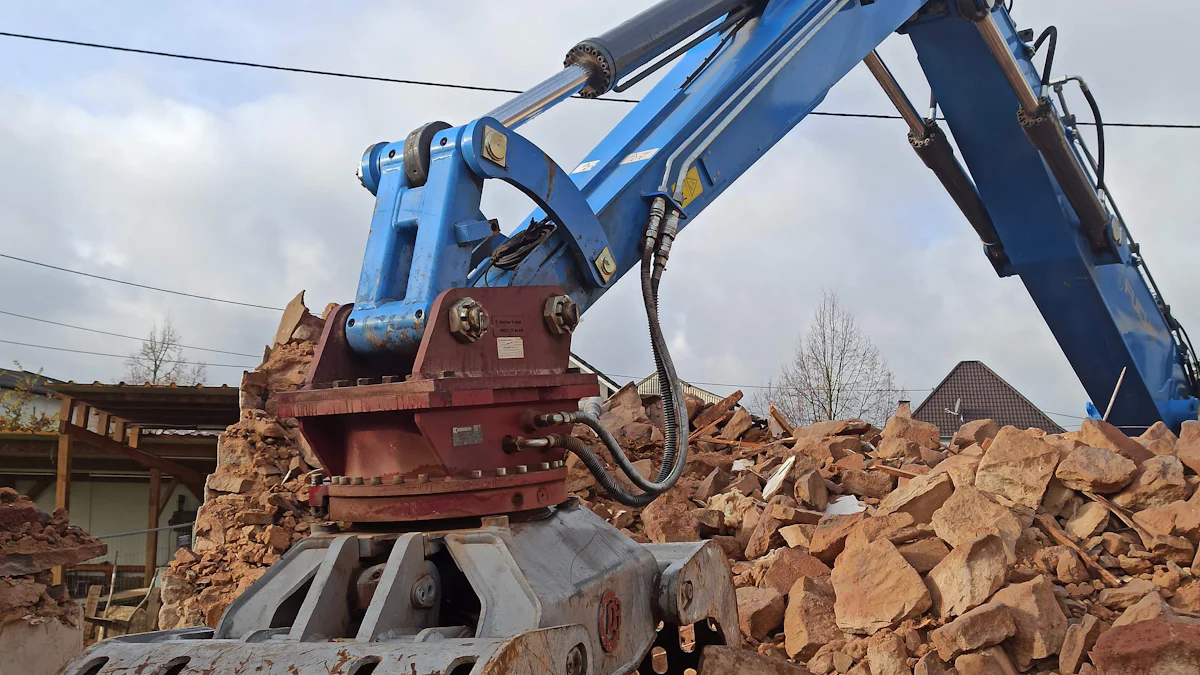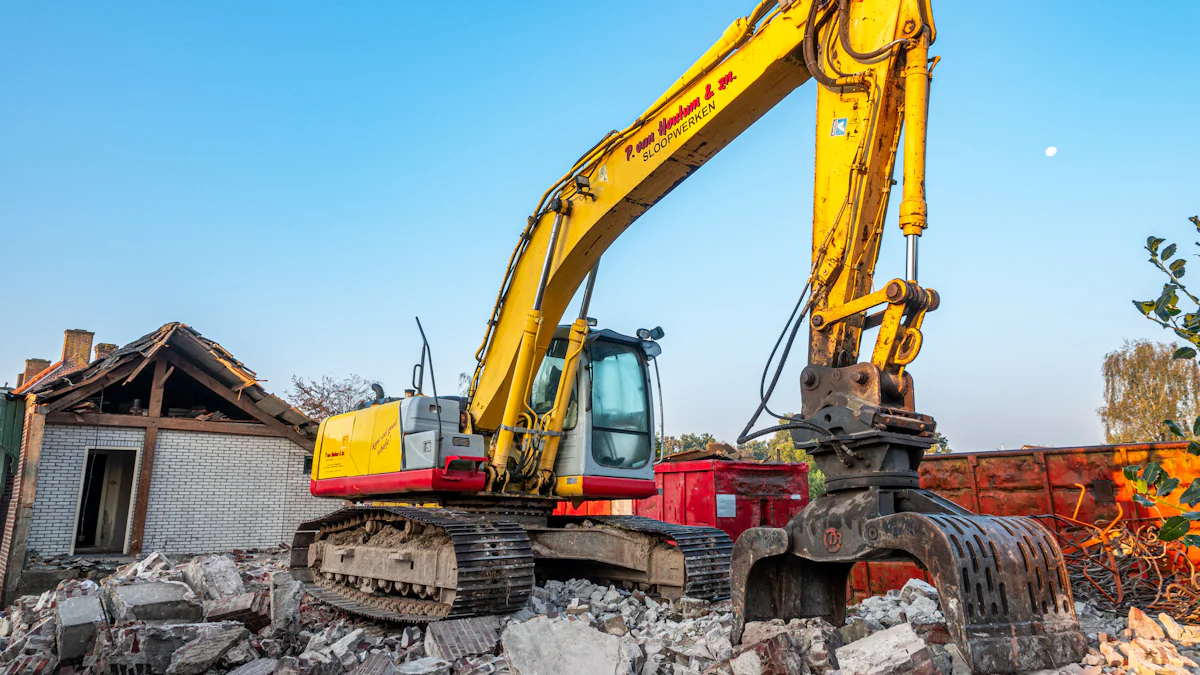
An excavator arm, often referred to as the stick, plays a crucial role in construction. It connects the boom to the bucket, allowing you to control the depth and precision of excavation tasks. By extending or retracting the arm, you can adjust the distance between the boom and bucket. This flexibility enables precise digging, grading, and lifting. The arm’s length varies depending on the size of the excavator, ensuring it meets specific construction needs. Understanding its function helps you appreciate its importance in achieving efficient and accurate excavation.
Understanding the Excavator Arm
Definition and Purpose
The excavator arm is a pivotal component of construction machinery. It connects the boom to the bucket, enabling precise control over excavation tasks. This arm functions through a series of hinges, allowing it to raise, lower, extend, and retract. Such versatility makes it indispensable for various operations like digging, bailing, loading, and placing materials. The arm’s design ensures that you can manipulate the bucket with accuracy, which is crucial for effective construction work.
Importance in Construction Operations
In construction, the excavator arm plays a vital role. It provides the necessary reach and depth for excavation, making it essential for tasks such as trenching, stripping, and drilling. The arm’s ability to handle different attachments enhances its functionality, allowing you to perform a wide range of activities efficiently. Whether you’re involved in small-scale projects or large-scale operations, the excavator arm’s adaptability and strength contribute significantly to productivity and cost-effectiveness. By understanding its importance, you can better appreciate how it supports various construction methods and improves overall efficiency.
Main Components of an Excavator Arm

The Boom
Function and Design
The boom serves as the backbone of the excavator arm. It connects the machine’s body to the stick, providing the necessary support and stability. The boom’s design allows it to pivot and lift, enabling you to reach different heights and angles during excavation. Manufacturers often offer various boom lengths to cater to specific project needs. For instance, a longer boom might be ideal for dredging or demolition tasks, while a shorter one could be more suitable for confined spaces.
Role in Providing Reach and Height
The boom plays a crucial role in determining the reach and height of your excavator arm. By adjusting the boom’s length, you can tailor the machine’s capabilities to the demands of your project. A longer boom provides greater reach, allowing you to access hard-to-reach areas or perform deep excavations. Conversely, a shorter boom offers better maneuverability, which is essential for working in tight spaces. This flexibility ensures that you can choose the right configuration for any task.
The Stick
Function and Design
The stick, also known as the arm, connects the boom to the bucket. Its primary function is to extend and retract, allowing you to control the distance between the boom and the bucket. This movement is essential for precise digging, grading, and lifting. The stick’s design includes a series of hinges that facilitate smooth and controlled motion. Depending on the size of the excavator, the stick’s length can vary, with mini excavators having shorter sticks for better maneuverability.
Role in Extending and Retracting
The stick’s ability to extend and retract is vital for adjusting the excavator arm’s reach. By extending the stick, you can increase the distance between the boom and the bucket, enabling deeper excavations. Retracting the stick brings the bucket closer, which is useful for tasks that require precision and control. This versatility makes the stick an indispensable component of the excavator arm, allowing you to adapt to various construction challenges.
The Bucket
Function and Design
The bucket’s design includes teeth or edges that enhance its ability to penetrate and scoop materials efficiently. bucket’s design includes teeth
Role in Digging and Scooping
The bucket’s primary role is to dig and scoop materials, making it a critical component of the excavator arm. Its design allows you to perform a wide range of tasks, from simple digging to complex material handling. By choosing the right bucket for your project, you can enhance the excavator’s efficiency and productivity. Whether you’re working on a small-scale project or a large construction site, the bucket’s versatility ensures that you can tackle any challenge with ease.
Attachments
Types of Attachments
Excavator arms can accommodate a variety of attachments, each designed to enhance the machine’s versatility. You can choose from a wide range of options depending on your project’s requirements. Common attachments include:
Hydraulic Breakers: Ideal for breaking through concrete or rock.
Grapples: Useful for handling materials like logs or scrap metal.
Augers: Perfect for drilling holes in the ground for posts or foundations.
Rippers: Designed to break up hard soil or ice.
These attachments transform your excavator into a multi-functional tool, allowing you to tackle diverse tasks with ease. By selecting the right attachment, you can significantly improve your machine’s efficiency and productivity.
Specialized Functions
Each attachment serves a specialized function, enabling you to perform specific tasks more effectively. For instance, hydraulic breakers provide the power needed to demolish concrete structures, while grapples offer precision in handling irregularly shaped materials. Augers make drilling operations straightforward, and rippers are indispensable for breaking up tough surfaces.
“Long reach excavators come with various boom and stick options that cater to different project needs,” says an expert in excavators. This flexibility extends to attachments, allowing you to customize your equipment for any job.
By understanding the specialized functions of each attachment, you can optimize your excavator’s capabilities. This knowledge ensures that you select the most suitable tools for your construction projects, enhancing both performance and efficiency.
How Excavator Arm Parts Work Together
Coordination of Boom, Stick, and Bucket
The excavator arm operates as a cohesive unit, with the boom, stick, and bucket working in harmony. Each component plays a distinct role, yet they must coordinate seamlessly to achieve optimal performance. The boom provides the necessary reach and height, acting as the primary support structure. It pivots and lifts, setting the stage for the stick’s movements.
The stick, often referred to as the arm, extends and retracts to adjust the distance between the boom and the bucket. This movement is crucial for precise digging and lifting tasks. The bucket, attached to the end of the stick, performs the actual digging and scooping. Its design allows it to penetrate the ground and handle materials efficiently.
Together, these components form a dynamic system. You control the coordination through hydraulic systems, which provide the power and precision needed for complex tasks. By mastering this coordination, you can enhance the excavator’s efficiency and productivity.
Performing Tasks like Digging, Lifting, and Moving Materials
The excavator arm excels in performing a variety of tasks, including digging, lifting, and moving materials. When digging, the boom and stick work together to position the bucket at the desired depth and angle. The bucket then scoops the material, and the arm lifts it to the designated location.
For lifting tasks, the boom provides the necessary height and stability, while the stick adjusts the reach. This combination allows you to lift heavy loads with precision. Moving materials involves similar coordination, with the arm positioning the bucket to transport materials efficiently.
Attachments further enhance the excavator’s capabilities. For example, hydraulic breakers can break through concrete, while augers dig holes quickly. These attachments transform your excavator into a versatile tool, capable of tackling diverse projects with ease.
By understanding how these parts work together, you can optimize your excavator’s performance. This knowledge ensures that you select the right configuration and attachments for your specific needs, maximizing efficiency and effectiveness on the job site.
Choosing the Right Excavator Arm Configuration

Selecting the right excavator arm configuration is crucial for maximizing efficiency and productivity on your construction site. The configuration you choose can significantly impact how well the machine performs specific tasks. Here are some key factors to consider when making your decision:
Factors to Consider
Project Requirements: Assess the specific needs of your project. Determine the type of work you will be doing, such as digging, lifting, or material handling. Different tasks may require different arm lengths or attachments.
Machine Size: Consider the size of your excavator. Larger machines can handle longer arms, which provide greater reach and depth. Smaller machines may require shorter arms for better maneuverability in confined spaces.
Terrain and Environment: Evaluate the terrain and environmental conditions of your worksite. Rough or uneven terrain may necessitate a more robust configuration to ensure stability and safety.
Attachments: Think about the attachments you plan to use. Some attachments, like hydraulic breakers or augers, may require specific arm configurations to function optimally.
Hydraulic System: Ensure that the hydraulic system of your excavator can support the chosen arm configuration. Hydraulic systems in long reach excavators are designed to handle extended reach and heavier loads, providing the necessary power and precision.
Impact on Productivity and Efficiency
Choosing the right excavator arm configuration directly affects your productivity and efficiency. A well-suited configuration allows you to complete tasks more quickly and with greater accuracy. Here’s how it impacts your operations:
Enhanced Precision: The right arm configuration provides precise control over excavation depth and positioning. This precision reduces the need for rework and increases the quality of your work.
Increased Reach and Depth: A longer arm configuration offers greater reach and depth, enabling you to access hard-to-reach areas and perform deep excavations efficiently.
Improved Versatility: By selecting an arm configuration that accommodates various attachments, you can transform your excavator into a multi-functional tool. This versatility allows you to tackle a wide range of tasks without needing additional equipment.
Optimized Performance: A configuration that matches your project requirements ensures that your excavator operates at peak performance. This optimization leads to faster completion times and reduced operational costs.
By carefully considering these factors and understanding the impact of your choice, you can select an excavator arm configuration that enhances your construction operations. This decision not only improves efficiency but also contributes to the overall success of your projects.
Enhancing Excavator Arm Efficiency
Maintenance Tips
Regular maintenance of your excavator arm ensures optimal performance and longevity. Here are some essential tips to keep your equipment in top shape:
Inspect Regularly: Conduct routine inspections to identify any signs of wear or damage. Look for cracks, rust, or loose bolts. Early detection prevents minor issues from becoming major problems.
Lubricate Moving Parts: Apply lubricant to all moving parts, including hinges and joints. Proper lubrication reduces friction and wear, extending the life of your excavator arm.
Check Hydraulic Systems: Ensure that hydraulic systems function correctly. Inspect hoses and connections for leaks or damage. A well-maintained hydraulic system provides the power needed for precise control.
Clean After Use: Remove dirt and debris from the arm after each use. Cleaning prevents buildup that can cause corrosion or interfere with moving parts.
Follow Manufacturer Guidelines: Adhere to the maintenance schedule and guidelines provided by the manufacturer. These recommendations are tailored to your specific equipment model.
By following these maintenance tips, you can enhance the efficiency and reliability of your excavator arm, ensuring it performs optimally on the job site.
Best Practices for Operation
Operating an excavator arm efficiently requires skill and attention to detail. Implement these best practices to maximize productivity and safety:
Understand Your Equipment: Familiarize yourself with the controls and capabilities of your excavator. Knowing how each component functions allows you to operate the machine more effectively.
Plan Your Work: Before starting a task, plan your approach. Consider the reach and depth required, and choose the appropriate arm configuration. Planning reduces unnecessary movements and increases efficiency.
Use Appropriate Attachments: Select attachments that match the task at hand. The right attachment enhances the versatility of your excavator, allowing you to perform a wide range of activities efficiently.
Maintain Proper Posture: Position the excavator arm correctly to maintain balance and stability. Proper posture prevents tipping and ensures safe operation.
Monitor Load Limits: Be aware of the load limits of your excavator arm. Overloading can cause damage and reduce the lifespan of your equipment.
Stay Alert: Remain vigilant while operating the excavator. Pay attention to your surroundings and be prepared to adjust your actions as needed.
Implementing these best practices helps you operate your excavator arm safely and efficiently. By understanding your equipment and planning your tasks, you can enhance productivity and achieve successful outcomes on your construction projects.
Practical Tips for Selecting and Using Excavator Arms
Assessing Job Requirements
When selecting an excavator arm, you must first assess the specific requirements of your job. Understanding the nature of the tasks at hand will guide you in choosing the right equipment. Consider the following:
Type of Work: Identify whether your project involves digging, lifting, or material handling. Each task may require different arm lengths or attachments.
Project Scale: Determine the size of your project. Large-scale operations might need longer arms for extended reach, while smaller projects could benefit from shorter arms for better maneuverability.
Site Conditions: Evaluate the terrain and environmental conditions. Rough or uneven ground may require a more robust arm configuration to ensure stability and safety.
By thoroughly assessing these factors, you can make informed decisions that enhance your project’s efficiency and effectiveness.
Matching Arm Features to Tasks
Once you’ve assessed your job requirements, match the features of the excavator arm to the tasks you need to perform. This alignment ensures optimal performance and productivity. Here are some key considerations:
Arm Length: Choose an arm length that suits your project’s needs. Longer arms provide greater reach and depth, ideal for deep excavations or accessing hard-to-reach areas. Shorter arms offer better control and maneuverability, perfect for confined spaces.
Attachments: Select attachments that complement the tasks you plan to undertake. For example, hydraulic breakers are excellent for demolishing concrete, while augers are perfect for drilling holes. The right attachment transforms your excavator into a versatile tool.
Hydraulic System: Ensure the hydraulic system can support the chosen arm configuration. A well-maintained hydraulic system provides the power and precision needed for complex tasks. Regular maintenance helps identify and address minor issues before they escalate, reducing downtime and enhancing productivity.
Load Capacity: Be mindful of the load limits of your excavator arm. Overloading can cause damage and reduce the lifespan of your equipment. Always operate within the recommended capacity to maintain safety and efficiency.
By carefully matching arm features to your tasks, you optimize your excavator’s capabilities. This strategic approach not only improves performance but also contributes to the success of your construction projects.
Understanding the excavator arm and its components is crucial for efficient construction operations. The boom, stick, and bucket work together to perform tasks like digging and lifting. Choosing the right configuration enhances productivity and reduces costs. Consider project requirements, machine size, and terrain when selecting an arm. Long reach excavators can significantly improve efficiency by reaching depths of up to 40 feet. By assessing job needs and matching arm features, you ensure optimal performance. This strategic approach maximizes your project’s success and cost-effectiveness.





